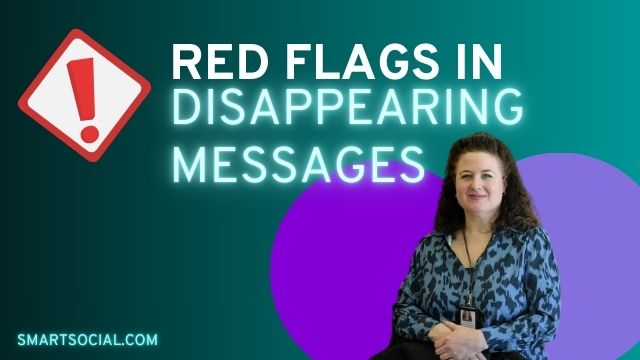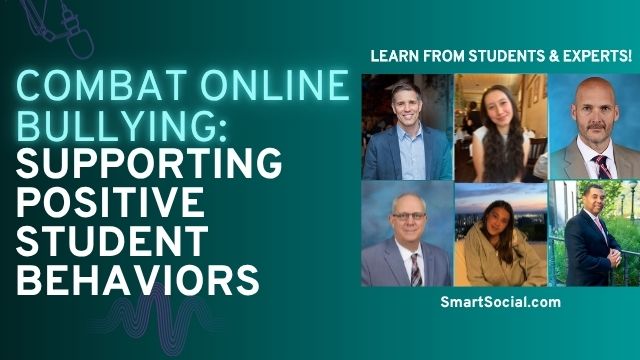Disappearing Messages: The Hidden Dangers Parents Need to Know
Green Zone App
(Click here to learn more)
Dangerous Social media challenge
(Click here to learn more)
Red Zone App
(Click here to learn more)
Gray Zone App
(Click here to learn more)
Disappearing messages have become a popular way for teens to communicate privately on apps like Snapchat, Instagram, and WhatsApp. While these features promise privacy by making messages “vanish” after they’re read, they can open doors to serious risks. From cyberbullying and impulsive behavior to data privacy concerns and predatory manipulation, disappearing messages create hidden dangers that parents need to understand.
In this SmartSocial guide, we’ll explore the top risks of disappearing messages, identify red flags, and offer practical conversation starters to help you discuss these issues with your teen, empowering you to support them in navigating the complex online landscape safely.
Educators and parents: Guide your students' reflection and discussion with this student worksheet. (Log in to your Google account and select File-->Make a Copy)
Event Replay (Parent Video)
Top dangers of disappearing messages
- False sense of security created by the belief these messages truly disappear. In reality they can easily be screenshot, recovered and shared
- Escalating risky behaviors including making impulsive decisions and sharing inappropriate images
- Vulnerability to cyberbullying due to lack of accountability and evidence, leading to emotional harm
- Loss of oversight and control - not being able to provide guidance, leading to a parent’s feeling of helplessness
- Privacy and security of your child’s data, due to your child’s false belief that the data they share can’t be captured by a third party and used by hackers
- Long-term impact that can result from your child’s content being unknowingly captured and used against them, potentially harming their reputation or future opportunities
What parents need to consider about disappearing messages
- Why does your child feel the need to communicate using an app with disappearing messages?
- Where is your level of trust with your child?
- If your child is moving between multiple apps to communicate using disappearing messages, this is a red flag
- Have a conversation warning them of the dangers of cyberbullying and sending inappropriate messages/images
What predators say to kids on social media
- “Let’s turn on vanishing mode” (so content will disappear)
- “Set up another Instagram account and chat with me there” (finstagram accounts parents can’t see)
- “You’re so pretty. I understand you, your parents don’t get you” (build trust/groom)
- “Your parents wouldn’t understand, don’t tell them we talked” (hide the relationship)
- “How old are you? Where are you? What school do you go to?” (collecting personal information)
- “Here’s a photo of me, now send one of you” (pushing to get an inappropriate photo of your child)
- “Send another photo or I will send this photo to all of your friends and family” (harassing, blackmailing, and threatening a student, causing extreme stress and humiliation)
Popular apps with disappearing messages
Snapchat
- Pioneering the concept, Snapchat allows users to send photos, videos, and messages that disappear after being viewed
- Family Center is Snapchat’s version of parental controls, but they do not allow parents to control the disappearing message feature
- Family Center will allow parents to:
- View your teen’s friends
- See who they’re chatting with (within the last 7 days)
- Restrict sensitive content in Stories and Spotlight
- Report abuse
- Parents cannot see messages and Snap content
- Instagram, owned by Facebook/Meta, offers a “vanishing mode” for users to send direct messages that vanish after the receiver reads the message and the chat is closed
- To send a vanishing message, open a direct message chat and swipe up. The screen will turn black and activate “Vanish mode”
- Instagram offers Parental Supervision tools, but they do not allow parents to turn off the Vanish mode feature for their teens
- WhatsApp, owned by Facebook/Meta, is a free messaging app for smartphones and desktops where users can send and receive messages, calls, photos, videos, documents, and voice messages
- There are no parental controls built into WhatsApp
Telegram
- Offers “Secret Chats” with self-destructing messages, allowing users to set a timer for messages to disappear
- Telegram is a free messaging app available on Android, iPhone, iPad, PC, MacOS
- There are no parental controls available within the Telegram app
Signal
- Signal is a free private messaging app that promises end-to-end encryption and allows users to enable a disappearing message feature for all messages
- The Signal app does not have built-in parental controls
iMessage
- iMessages through iOS allow users to “unsend” a message that has been sent (for up to 2 minutes)
Notes app
- The Notes app in the iPhone allows users to create a “note” and share it with others
- The user can also lock the specific note with Face ID so that only the phone owner can open the note and see the contents
Google Docs
- Google users can open up a document and share it with other users and send messages back and forth between them
- Information within the documents can be easily deleted by anyone with edit access
What can parents and educators do?
- Parents can educate themselves about the different apps that offer disappearing message features and the potential dangers of using these features
- Teach your child that nothing REALLY disappears. Texts and images can be easily screenshot and reposted online for all to se
Dialogue starters about disappearing messages
- “Have you ever used disappearing messages? What do you think about them?”
- “Do you feel like disappearing messages make conversations safer or riskier? What do you think the risks could be?”
- “Have you ever worried that something you said in confidence might be screenshot or shared?”
- “How would you feel if someone screenshot your private message and shared it with someone else without asking you?”
- “Who are the top 3 people you feel safe going to if you experience something online that makes you feel uncomfortable?”
Additional resources for parents
Negative Effects of Snapchat for Teens
Negative Effects of Social Media & Screen Time: What Parents, Educators, & Students Need to Know
Conclusion
Disappearing messages may seem like a safe way for teens to communicate, but they can quickly lead to unintended risks that impact their safety, privacy, and well-being. As parents, understanding these potential dangers and talking openly with your teen can make all the difference. By staying informed about how these apps work and encouraging your child to consider the long-term effects of their online interactions, you can help them make smarter, safer choices.
Protect your family and enter for a chance to win cool prizes
Become a member or log in to learn more on this topic
Protect your family and enter for a chance to win cool prizes

., start learning from this page to earn points!*
Hello, I'm Josh, the founder of SmartSocial.com.
Don't leave this page until you fill out our feedback form that will appear after you learn from the resources...
Become a Very Informed Parent (VIP) to get our social media suggestions in your email every Tuesday & Thursday.



Hello, I'm Josh, the founder of SmartSocial.com. Protect your family by taking my 1 minute quiz
This quiz will help you understand how safe your family is


Schools & Districts: Partner with us to protect your community online
Our remote presentations (and website) teach over a million parents and students each year how to be safe so they can shine online. We teach students how their accounts can be used to create a portfolio of positive accomplishments that impress colleges and employers.


Join Our Smart Social Podcast
each week on iTunes
With over 500 episodes, Josh Ochs interviews psychologists, therapists, counselors, teachers, and parents while showing you how to navigate social media to someday shine online.
Listen on:









.jpg)
.jpg)
.jpg)


